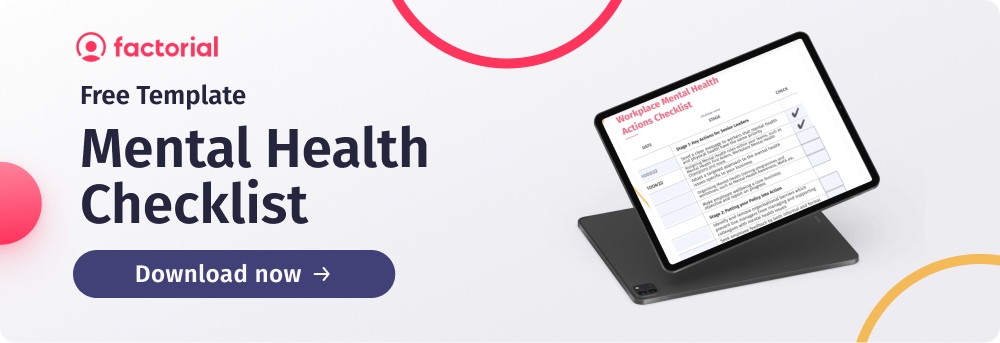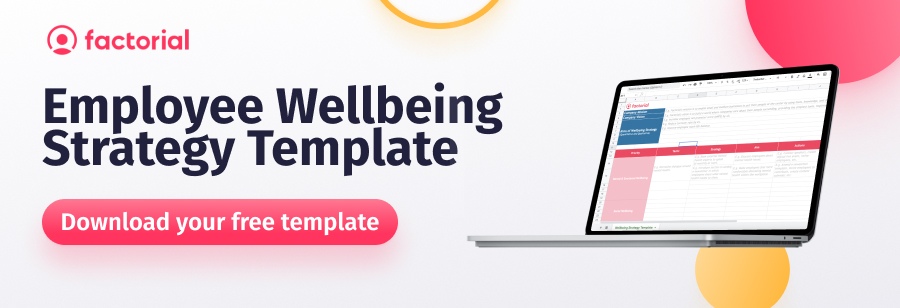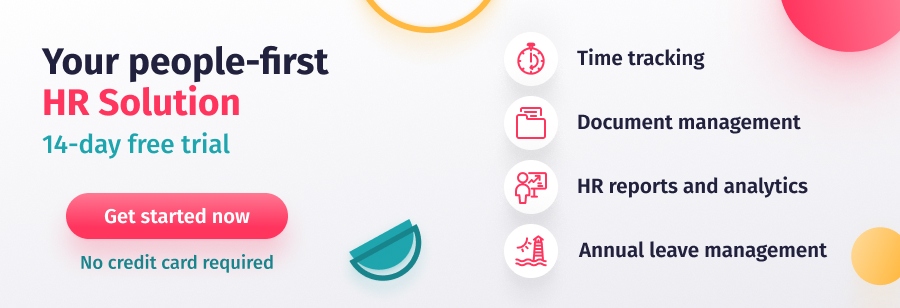For any organisation, one major responsibility is creating a supportive and healthy environment that enables teams to thrive. One way you can implement such an environment is through an employee wellbeing strategy that prioritises the physical, mental and emotional health of the people in your organisation.
A wellbeing strategy isn’t just a nice-to-have. It’s a critical component of the talent management cycle of any organisation that values its teams. By investing in wellbeing at work, you can reduce absenteeism, improve engagement and ultimately drive better business outcomes. To do so, you can take multiple angles when exploring and building an effective wellbeing strategy that caters to the unique needs of your teams.
In this article, we’ll take a deep dive into the different steps involved in creating a comprehensive plan, including assessing the needs of your people, setting objectives, identifying resources and measuring success.
- What are your Team’s Needs?
- How to Execute your Employee Wellbeing Strategy
- Measuring the Success of your Employee Wellbeing Strategy
- Employee Wellbeing Strategy Templates

What are your Team’s Needs?
Research shows that, every year, 44% of work-related ill health cases and 54% of all working days lost are due to stress and anxiety, with the average employee absence being 5.9 days, or 2.6% of working time lost. Creating a comprehensive and effective wellbeing strategy is an effective way to avoid this by promoting happiness, productivity, and employee health and wellbeing in the workplace.
By assessing your team’s needs, you can begin to build a staff wellbeing strategy that is targeted and effective. Listen to your team members and prioritise their feedback as you develop your strategy. Doing so can help create a more engaged, productive and successful organisation.
Conduct Surveys or Focus Groups
Building a successful employee wellbeing strategy requires you to gather data on the current state of your team. Conducting a targeted survey or focus group is an effective strategy that will help you gain a clear picture. Any data you collect will allow you to identify areas of concern and common stressors or issues impacting your team.
Identify Common Stressors or Issues
Once you have collected data on your team’s wellbeing, you can begin identifying common stressors or issues affecting wellbeing at work. This could be related to workload, communication, work-life balance or team dynamics. By understanding these stressors or issues, you can develop targeted strategies to address them and improve overall staff wellbeing.
Prioritise Areas to Address
After careful consideration of both the feedback from your team, and the organisational goals you have set, you can strike a balance between the two, addressing your team members’ immediate needs and ensuring that your employee wellbeing strategy aligns with your organisation’s long-term goals.
How to Execute your Employee Wellbeing Strategy
When starting on your wellbeing strategy, there are a few key elements to look out for to ensure your strategy will be a successful one. You’ll want to check that you’re building a culture of wellbeing, which activities or programmes are received well and how it is progressing. This will allow you to adjust as needed to achieve the best results.
Build a Culture of Wellbeing
Your working environment should foster a sense of support, connection and value for all the people in your team. One place to start is at the top, encouraging the organisation’s leaders to model healthy behaviours and habits that promote wellbeing, setting the right tone for the right culture.
You can also establish employee wellbeing initiatives for every branch of your organisation, such as encouraging people to take breaks during the workday or organising team outings that promote physical activity or socialising. This can develop a stronger sense of community and support among teams, and encourage peer-to-peer recognition.
Identify Activities or Programmes for your Teams
Workplace activities or programmes can have many long-term benefits. Research shows these strategies can significantly improve absenteeism rates, work performance and productivity. Some examples include:
- Offer flexible work arrangements to promote work-life balance.
- Provide access to mental health resources and support services.
- Host team-building events or activities that promote physical activity or socialisation.
- Provide opportunities for personal and professional development, such as courses.
Make your Wellbeing Strategy Inclusive and Accessible
No two people are the same. To succeed in your staff wellbeing strategy you need to account for everyone’s unique needs and circumstances. There are a few factors to keep in mind:
- Offer a variety of resources and options to accommodate different learning styles and preferences.
- Ensure that wellbeing resources are accessible to people with disabilities or other special needs.
- Promote diversity and inclusion within the workplace culture to promote a sense of belonging and psychological safety.
Share your Wellbeing Strategy with your Team
Simply developing a wellbeing strategy is not enough. It’s also important to communicate the strategy to your team in a way that encourages:
- Clarity: Everyone understands the wellbeing programme’s goals, objectives and strategies. If there is a lack of communication, there could be confusion about what the strategy entails, leading to misinterpretation or misalignment between the team and the strategy.
- Engagement: Effective communication helps to engage teams and encourage their participation. By regularly communicating progress reports and providing feedback opportunities, teams will feel included in the strategy and more motivated to participate and make positive changes.
- Trust: It’s about building a culture of transparency and trust. When team members feel that their feedback is being heard and their concerns are being addressed, they will be more likely to trust their employer and feel supported in their efforts to improve their wellbeing.

Measuring the Success of your Employee Wellbeing Strategy
Numbers don’t mean everything, but they play a crucial part in determining whether your wellbeing strategy is headed in the right direction. After all, we need to ensure that our strategies are useful in building a positive company culture. This can be done through collecting and gathering data to track your strategy’s performance.
Clearly Define what Metrics to Base your Wellbeing Strategy on
It’s important to establish metrics that can be tracked and analysed. These metrics should align with the goals and objectives of the strategy and should provide insight into how the strategy impacts the teams or people within the organisation. Some key metrics to consider include:
- Engagement: Track whether your wellbeing strategy positively impacts how teams or people feel about their work and the organisation.
- Absenteeism: Determine if the wellbeing strategy reduces the number of sick days taken by teams or people.
- Productivity: Analyse your team’s productivity levels and establish how efficiently everyone works.
How to Collect your Data
Collecting data on the established metrics is how you measure your success of the employee wellbeing strategy. You can do so by using:
- Surveys: Surveys can gather data directly from teams or people about their engagement, absenteeism and productivity levels.
- Performance Reviews: Performance reviews can provide valuable insight into how the wellbeing strategy impacts team or people performance.
- Absence Records: Absence records can be used to track absenteeism rates before and after implementing the wellbeing strategy.
Once you’ve got the numbers, you can compare data from before and after the strategy began and look for trends in the data. Always involve your teams in this analysis process and use the data to inform future adjustments to your strategy.
Employee Wellbeing Strategy Template
If you’re struggling through the development process, there are frameworks for developing targeted and effective wellbeing strategies, like our free wellbeing strategy template. This can act as a foundation, helping organisations pinpoint the key components and steps needed.
They can also serve as a reference guide, keeping organisations on track and allowing for potential adjustments. While there are many you can take inspiration from, here are a few popular and successful approaches that have stood the test of time:
- The Five Pillars Model: This model provides a framework for building a comprehensive staff wellbeing strategy focusing on five key areas: physical health, emotional wellbeing, social connectedness, financial security, and purpose and meaning. By addressing these key areas, organisations can create a holistic employee wellbeing strategy that supports overall health and wellbeing in the workplace.
- The PERMA Model: This measure focuses on five key elements, which are positive emotion, engagement, relationships, meaning and accomplishment. These will allow organisations to build resilience, reduce stress, and enhance overall team wellbeing.
- The SMART Wellbeing Strategy: This framework provides a structure for developing clear and measurable wellbeing goals that are Specific, Measurable, Achievable, Relevant, and Time-bound. By using this framework, organisations can ensure that their wellbeing goals are well-defined, actionable, and can be effectively tracked and evaluated for progress.#









